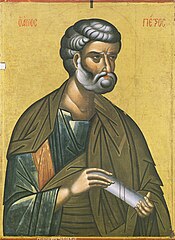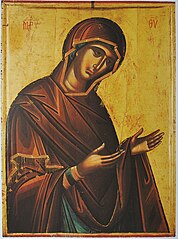Euphrosynos
Euphrosynos | |
|---|---|
 Icon of Jesus by Euphrosynos | |
| Born | 16th Century |
| Died | 16th Century |
| Nationality | Greek |
| Known for | Iconography and hagiography |
| Movement | Cretan School |
Euphrosynos (Greek: Ευφρόσυνος, fl. 16th century) was a Greek Renaissance painter. He was a priest and influenced by Byzantine art and the early Cretan School. Five of his works have survived, all of them are in Greece. His technique resembled the works of Andreas Pavias, Angelos Akotantos, and Andreas Ritzos. Euphrosynos may have been a member of the prominent Klontzas family. His paintings of the Virgin Mary and Jesus are typical Cretan School paintings. His Jesus painting resembles Pavias's painting Christ Pantocrator. All of his works are at Mount Athos in the Dionysiou Monastery. They decorate the iconostasis. Fragkos Katelanos and Theophanes the Cretan were also working at Mount Athos around the same period.[1][2][3][4][5][6][7]
History[edit]
Euphrosynos was born in Crete sometime in the 16th century. He was a priest. The only information regarding his life remains in five icons. His icons are in the Dionysiou Monastery, Mount Athos, Greece. His style resembles Theophanes the Cretan. There are rumors within the historical community that he was a member of the Klontzas family. In 1567, a priest is mentioned by the name Euphrosynos Klontzas. Regrettably, there is no record indicating that Euphrosynos Klontzas was a painter. His paintings resemble the typical Cretan School. Michael Damaskinos was also active in Crete around the same period. Euphrosynos's paintings are dated around 1542. They are of Jesus, the Virgin Mary, John the Baptist, Peters, and Paul. His signature was Γραφέος θύτου τεΰξεν χείρ ταπεινού Ευφρόσυνου.[1]
Gallery[edit]
-
St. Peter
-
The Virgin Mary
-
Jesus Christ Pantocrator
-
St. John the Baptist
-
St. Paul
References[edit]
- ^ a b Hatzidakis, Manolis (1987). Έλληνες Ζωγράφοι μετά την Άλωση (1450-1830). Τόμος 1: Αβέρκιος - Ιωσήφ [Greek Painters after the Fall of Constantinople (1450-1830). Volume 1: Averkios - Iosif]. Athens: Center for Modern Greek Studies, National Research Foundation. pp. 289–290. hdl:10442/14844. ISBN 960-7916-01-8.
- ^ Eugenia Drakopoulou (September 5, 2021). "Effrosynos (1)". Institute for Neohellenic Research. Retrieved September 5, 2021.
- ^ "The Art of Mount Athos". Macedonian Heritage. September 5, 2021. Retrieved September 5, 2021.
- ^ Chatzidakis M. (September 5, 2021). "The Painter Euphrosynos". Society of Cretan Historical Studies & Kalokerinos' family. Retrieved September 5, 2021.
- ^ Sethre, Janet (2020). Venice: Souls' Mother and Child. Venice, Italy: Strategic Book Publishing & Rights Agency. p. 121. ISBN 9781951530242.
- ^ Hatzidakis, Manolēs (1972). Studies in Byzantine Art and Archaeology. Athens, Greece: Museum Benaki. p. 20. ISBN 9780902089242.
- ^ Talbot Rice, David (1974). Icons and their history. New York, NY: Overlook Press. pp. 71, 72, 183. ISBN 9780879510213.





